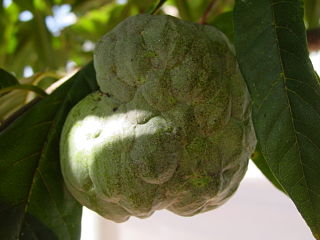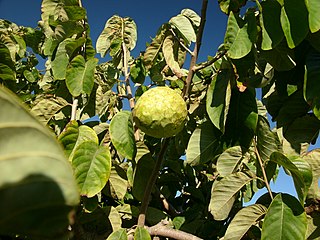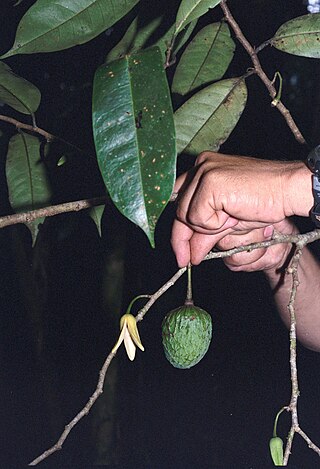
Soursop is the fruit of Annona muricata, a broadleaf, flowering, evergreen tree. It is native to the tropical regions of the Americas and the Caribbean and is widely propagated. It is in the same genus, Annona, as cherimoya and is in the Annonaceae family.

The Annonaceae are a family of flowering plants consisting of trees, shrubs, or rarely lianas commonly known as the custard apple family or soursop family. With 108 accepted genera and about 2400 known species, it is the largest family in the Magnoliales. Several genera produce edible fruit, most notably Annona, Anonidium, Asimina, Rollinia, and Uvaria. Its type genus is Annona. The family is concentrated in the tropics, with few species found in temperate regions. About 900 species are Neotropical, 450 are Afrotropical, and the remaining are Indomalayan.

The cherimoya, also spelled chirimoya and called chirimuya by the Inca people, is a species of edible fruit-bearing plant in the genus Annona, from the family Annonaceae, which includes the closely related sweetsop and soursop. The plant has long been believed to be native to Ecuador and Peru, with cultivation practised in the Andes and Central America, although a recent hypothesis postulates Central America as the origin instead, because many of the plant's wild relatives occur in this area.

Annona or Anona is a genus of flowering plants in the pawpaw/sugar apple family, Annonaceae. It is the second largest genus in the family after Guatteria, containing approximately 166 species of mostly Neotropical and Afrotropical trees and shrubs.

Custard apple is a common name for several fruits and may refer to Annonaceae, the custard apple family, which includes the following species referred to as custard apples:

Annona reticulata is a small deciduous or semi-evergreen tree in the plant family Annonaceae. It is best known for its fruit, called custard apple, a common name shared with fruits of several other species in the same genus: A. cherimola and A. squamosa. Other English common names include ox heart and bullock's heart. The fruit is sweet and useful in preparation of desserts, but is generally less popular for eating than that of A. cherimola.

Annona squamosa is a small, well-branched tree or shrub from the family Annonaceae that bears edible fruits called sugar apples or sweetsops. It tolerates a tropical lowland climate better than its relatives Annona reticulata and Annona cherimola helping make it the most widely cultivated of these species. Annona squamosa is a small, semi-(or late) deciduous, much-branched shrub or small tree 3 to 8 metres tall similar to soursop. It is a native of tropical climate in the Americas and West Indies, and Spanish traders aboard the Manila galleons docking in the Philippines brought it to Asia.

Annona glabra is a tropical fruit tree in the family Annonaceae, in the same genus as the soursop and cherimoya. Common names include pond apple, alligator apple, swamp apple, corkwood, bobwood, and monkey apple. The tree is native to Florida in the United States, the Caribbean, Central and South America, and West Africa. It is common in the Everglades. The A. glabra tree is considered an invasive species in Sri Lanka and Australia. It grows in swamps, is tolerant of saltwater, and cannot grow in dry soil.

Annona purpurea is an edible fruit and medicinal plant in the Annonaceae family. It is native to Mexico, Central America, and parts of South America. Its common names include soncoya, sincuya, and cabeza de negro.

Annona montana, the mountain soursop, is a tree and its edible fruit in the Annonaceae family native to Central America, the Amazon, and islands in the Caribbean. It has fibrous fruits. A. montana may be used as a rootstock for cultivated Annonas.
Annona cacans, with the common names: Araticum-cagão, Araticum de paca, Araticum-pacarí, is a fruit tree native to Atlantic Forest and Cerrado vegetation in Brazil and Paraguay.

Annona crassiflora, commonly known as marolo, araticum cortiça, araticum do cerrado or bruto, is a flowering plant in the Annonaceae family. The flowers of a marolo look like jellyfish wearing hats, and the fruits are sweet and very rough. It is native to Brazil and Paraguay and the fruit is eaten by native peoples in the Brazilian Cerrado. Although it is considered to have potential for cultivation, it has not been domesticated to date.
Annona cornifolia is a slow-growing shrub native to savannas and fields of the Cerrado region of Brazil, reaching a height of 4–5 meters. It prefers a sunny position on acidic, sandy soils and needs good drainage to thrive. After 4–5 years, if grown in full sun, it produces a blood red fruit, which has an orange aromatic, sweet and highly appreciated flesh containing few seeds. The tree resists frosts to -3 °C. It is little known outside of its native range. Propagation is by seeds which have orthodox storage behavior and may take up to 18 months to germinate. Its pollen is shed as permanent tetrads.

Annona aurantiaca is a species of plant in the family Annonaceae. It is native to Brazil. João Barbosa Rodrigues, the Brazilian botanist who first formally described the species, named it after its orange colored petals.
Annona cordifolia is a species of plant in the Annonaceae family. It is native to Bolivia, Brazil, Columbia and Peru.

Annona crassivenia is a species of plant in the family Annonaceae. It is native to Cuba. William Edwin Safford, the American botanist who first formally described the species, named it after the thick tertiary veins that interconnect the secondary veins of its leaves.
Annona foetida is a species of plant in the family Annonaceae. It is native to Bolivia, Brazil, Colombia, French Guiana, Peru and Suriname. Carl Friedrich Philipp von Martius, the German botanist who first formally described the species, named it after its foul-smelling odor.

Annona jahnii is a species of plant in the family Annonaceae. It is native to the Brazil, Colombia and Venezuela. William Edwin Safford, the American botanist who first formally described the species, named it after the Venezuelan scientist, explorer and mountain climber Alfredo Jahn.

Annona macroprophyllata is a species of plant in the family Annonaceae. It is native to El Salvador, Guatemala, Honduras and Mexico. John Donnell Smith, the American botanist who first formally described the species, named it after its large leaves.

Annona pittieri is a species of plant in the family Annonaceae. It is native to Costa Rica and Panamá. John Donnell Smith, the American taxonomist who first formally described the species, named it after Henri François Pittier, the Swiss botanist who collected specimen he examined.















